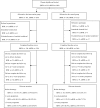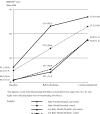Effectiveness of a breastfeeding self-efficacy intervention: do hospital practices make a difference?
- PMID: 23592322
- PMCID: PMC3880483
- DOI: 10.1007/s10995-013-1265-2
Effectiveness of a breastfeeding self-efficacy intervention: do hospital practices make a difference?
Abstract
Breastfeeding self-efficacy interventions are important for improving breastfeeding outcomes. However, the circumstances that may influence the effectiveness of the interventions are unclear, especially in the context of hospitals with suboptimal infant feeding practices. Thus, we aimed to evaluate the effect of a self-efficacy intervention on breastfeeding self-efficacy and exclusive breastfeeding, and further assessed the difference in its effect by hospital-routine type. In this intervention study with a control group, 781 pregnant women were recruited from 2 "Baby-Friendly"-certified hospitals (BFH) and 2 non-Baby-Friendly Hospitals (nBFH) in Japan, and were allocated to an intervention or control group. Participants in the intervention group were provided with a breastfeeding self-efficacy workbook in their third trimester. The primary outcome was breastfeeding self-efficacy and the secondary outcome was infant feeding status. All analyses were stratified by the type of hospital, BFH or nBFH. In BFHs, the intervention improved both breastfeeding self-efficacy through 4 weeks postpartum (p = 0.037) and the exclusive breastfeeding rate at 4 weeks postpartum (AOR 2.32, 95 % CI 1.01-5.33). In nBFHs, however, no positive effect was observed on breastfeeding self-efficacy (p = 0.982) or on the exclusive breastfeeding rate at 4 weeks postpartum (AOR 0.97, 95 % CI 0.52-1.81); in nBFHs, supplementation was provided for breastfed infants and the mother and infant were separated in the vast majority of cases. Infant feeding status at 12 weeks was not improved in either hospital type. The intervention improved breastfeeding self-efficacy and exclusive breastfeeding at 4 weeks postpartum only in BFHs. When breastfeeding self-efficacy interventions are implemented, hospital infant feeding practices may need to be optimized beforehand.
Figures


References
-
- Ip, S., Chung, M., & Raman, G., et al. (2007). Breastfeeding and maternal and infant health outcomes in developed countries: Evidence report/technology assessment no. 153. Rockville, MD: Agency for Healthcare research and Quality; AHRQ Publication no. 07-E. - PubMed
-
- WHO & UNICEF. (2009). Baby-Friendly Hospital Initiative-Revised, Updated, and Expanded for Integrated Care, 2009. Available at: http://www.unicef.org/nutrition/index_24850.html. Accessed December 28, 2011. - PubMed
-
- WHO . World Health Statistics 2011. Geneva: WHO; 2011.
Publication types
MeSH terms
LinkOut - more resources
Full Text Sources
Other Literature Sources
Medical

